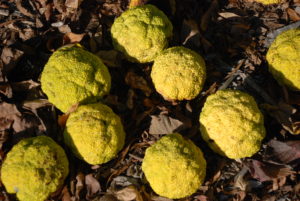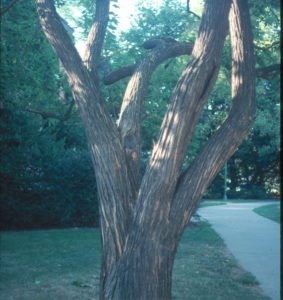Osage orange (Maclura pomifera) has been declawed and neutered (USDA Zones 5-9). A member of the mulberry family (Moraceae), this tough prairie tree species is native to east Texas, Oklahoma and Arkansas. It grows fast @ 2 ½ to 3 feet per year. It is also called Bois D’Arc (pronounced “bow-dark”).
Osage orange is a dioecious species. Female trees are generally not recommended for landscape use because the fruits pose a considerable litter problem. The “hedge apples” are large 4-6 inch wide yellowish green fruits. Each may weigh 2 to 3 pounds and fall from the tree in October to become a maintenance headache. Female trees need a male tree pollinator in order to produce fruit.
Fierce ½- inch long thorns, hidden within the dense branches, can do lots of harm, even puncture a vehicle tire. The bark on mature trees is deeply fissured, with an orange-brown inner wood peeking through. The wood is hard, does not split or rot, and makes great fence posts. A century ago, in lieu of fences, farmers in the South Central states planted thousands of miles of hedgerows of osage orange. The tree suckers freely and becomes a quagmire of vicious thorns.
Osage orange is easily grown in adequately drained soils in full sun to part shade. The tree grows almost anywhere, in poor infertile, acid or alkaline soils, and dry or wet fields. It also tolerates drought, heat, cold and wind. Disease and pest problems are practically non-existent. Its foliage is tolerant of urban air pollutants.
‘Wichita’ and ‘White Shield’ are fruitless and thornless (male) selections. Both cultivars are attractive landscape trees with deep green shiny foliage that turns a beautiful fall pale to golden yellow in fall. ‘Wichita’ grows slightly taller than ‘White Shield’, and its branching tends to be slightly more upright. ‘White Shield’ forms a rounded canopy, averaging 35 feet in height and spread. Trees bloom in late spring with tiny (mostly inconspicuous) green flower clusters.
Either cultivar is a good choice for large residential or commercial properties, city parks, and golf courses. Plant the tree under power lines or utilize as a deciduous windbreak.




 Posted in
Posted in 
